What is the 1-2-2 press defense in basketball
The 1-2-2 press defense is a basketball strategy that features moderate defensive pressure and sideline traps, particularly in the backcourt or frontcourt, which in turn, could limit offensive scoring opportunities.
What is an example of the initial formation for the 1-2-2 press defense
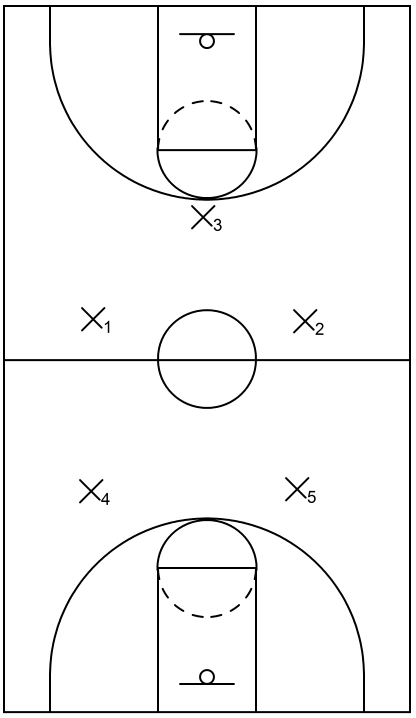
This is an example of the initial formation for the 1-2-2 press. X3 starts at the top above the three-point line. X1 and X2 start slightly above the half court line near the extended slots. X4 and X5 start above the three-point line near the slots in the frontcourt.
What are the general responsibilities of the defenders within the 1-2-2 press defense
The responsibilities of X3 are to execute initial backcourt defensive pressure, influence the player in possession of the ball near the sideline, and eventually set traps when the opportunity presents itself. Also, at certain times, X3 could protect the middle area of the press.
The responsibilities of X1 and X2 are to set traps and cover the middle area of the press. The responsibilities of X4 and X5 are to cover the area near the sideline in the frontcourt, protect the basket, or set sideline traps at certain instances.
What is an advantage of 1-2-2 press defense
One particular advantage of the 1-2-2 press defense is that it is essentially a low risk, high reward type of press. In other words, the 1-2-2 press defense can implement defensive pressure like many other types of press defenses.
However, unlike other press defenses, the defensive team does not necessarily have to aggressively focus on creating offense from their defense via turnovers, and more specifically, live-ball turnovers.
In simple terms, the 1-2-2 press defense is typically a containment-type press that has the general emphasis to disrupt the rhythm and flow of the offensive team and force them to execute several passes as they attempt to break the press.
It is also from these extra passes that could lead to potential turnovers as each pass increases the chances of the offensive team making mistakes. However, as stated previously, creating turnovers alone are not necessarily the primary focus of the 1-2-2 press but it is a welcome addition.
What is a disadvantage of 1-2-2 press defense
One general disadvantage of the 1-2-2 press defense is that the defenders have to cover quite a bit of ground, particularly in the backcourt. Therefore, the 1-2-2 press may not be as beneficial to defensive teams that possess less than ideal speed/quickness.
What are examples of the 1-2-2 press defense
Example 1

This is an example of the 1-2-2 press defense that features a possible sideline trap in the backcourt. To start, 1 receives the inbound pass from 4. Following that, X3 influences 1 to dribble towards the sideline via defensive pressure.
Next, X1 steps up to set a sideline trap alongside X3. Also, as that happens, X2 cuts toward the middle area, which limits the offensive team’s opportunities to break the press.
Furthermore, in the frontcourt, X4 could deny the potential sideline pass to 3 while X5 could drop back to protect the basket because 5 cuts below the frontcourt free throw line extended.
Example 2

This is an example of the 1-2-2 press defense that demonstrates what could occur if the player in possession of the basketball attempts to avoid the trap by throwing a backwards pass in the backcourt.
To begin, 4 receives the ball from 1 and when that happens, X3 should sprint towards 4 to execute defensive pressure and influence 4 towards the sideline.
At the same time, X2 should also cut towards the sideline to set a trap alongside X3. Additionally, in the frontcourt, X5 should sprint up towards the sideline to deny the potential pass while X4 drops back to protect the basket.
Example 3

This is another example of the 1-2-2 press defense but this time, 2 and 5 are also in the backcourt. For this scenario, 4 has already received the ball from 1 and immediately afterwards, X3 sprints towards 4 to execute defensive pressure.
From that point, 2 receives the ball from 4 and after that occurs, X2 and X3 attempt to set a sideline trap on 2. Also, X1 protects the middle area to prevent the easy pass to 5.
In the frontcourt area, X4 could cover the high post since there are no offensive players below the free throw line extended area. Additionally, X5 could deny or intercept the pass to 3.
Example 4 – Part 1
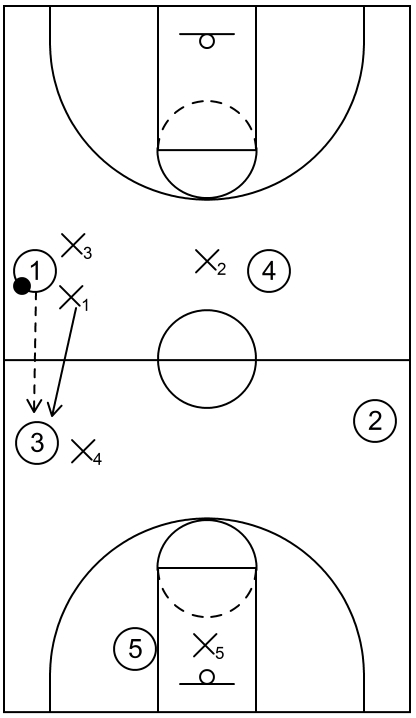
This is an example of the 1-2-2 press defense that demonstrates a sideline trap in the frontcourt area. To start, 3 receives the ball from 1 and when that occurs, X1 sprints into the frontcourt to set a trap alongside X4.
Also, X2 covers the middle area, similar to previous examples and X5 drops back to protect the basket as a counter to 5 cutting below the free throw line extended area near the low post block.
Example 4 – Part 2
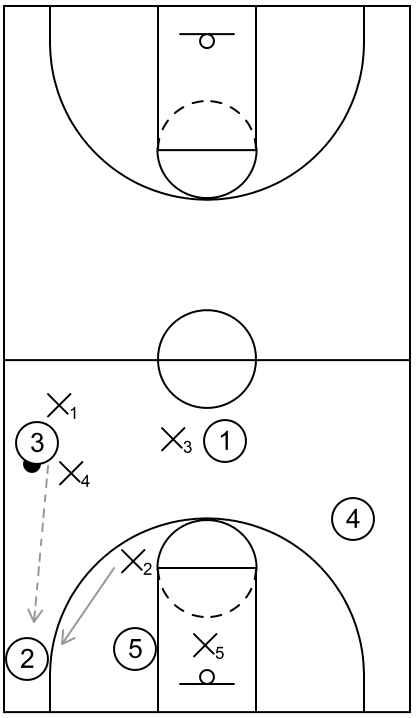
For this portion of the example, offensive players that were originally in the backcourt have now sprint into the frontcourt. Next, X2 could slide over from the high post, anticipating that 2 would receive the ball while X3 continues to cover the middle area.
Also, for this example, X2 should not necessarily fully commit to deny the corner pass towards 2 because 3 could simply counter that by throwing the skip pass to 4 and if that occurs, 4 would have a potential open jump shot or drive to the basket.
However, if 2 does receives the ball from 3, shown with a gray arrow, then X2 could sprint and execute a defensive closeout on 2, also shown with the gray arrow.
Affiliate Disclosure: I may earn a commission on qualifying purchases made through the links below.
What is an example of an alternative version of the 1-2-2 press defense
This is an example of an alternative version of 1-2-2 press defense which features a slightly modified setup from the previous examples as well as fake traps in the backcourt.
It is derived from 1-2-2 and 1-1-2-1 Three-Quarter Court Pressure Defense by Jay Wright.
Here are additional insights and rules that Coach Wright spoke about in reference to his 1-2-2 press philosophy:
The main objectives of implementing the 1-2-2 press are to set traps, which could lead to deflections or steals and to not give up three-pointers, especially on the ball side, which is the strong side of the court.
It is important that the player in possession of the basketball within the backcourt does not pass it to the middle of the court as that would essentially break the press.
However, if the ball does happen to get to the middle of the court via the dribble or the pass, then that results in an automatic conversion and chase from behind.
Additionally, if the offensive player with the ball is able to split the trap, then this also results in an automatic conversion and chase from behind.
Conversion basically means that all players will sprint towards the paint to protect the basket, load up to the ball side, prevent three-pointers on the ball side, and eventually match-up into man to man defense in a matter of a few seconds.
Furthermore, when setting a trap, off-ball defenders should step and slide over to the ball side of the court and take away passing options for the player in possession of the ball.
Moreover, it is okay to allow backward passes, as that could lead to a potential ten-second violation in the backcourt, or at the very least, a general disruption of the opposing team’s basketball offense strategies.
Also, in most cases, if the ball is in the backcourt and it is close to the end of the ten-second count, it is okay to set a trap near the sideline before the offensive player crosses the half court line.
Most of the time, though, defenders will fake traps in the backcourt to confuse the offensive player in possession of the ball while setting the actual traps in the frontcourt.
However, every four or five plays, defenders could set early traps in the backcourt because the initial fake trap would eventually become ineffective if the player in possession of the ball always knew it was not real.
Part 1
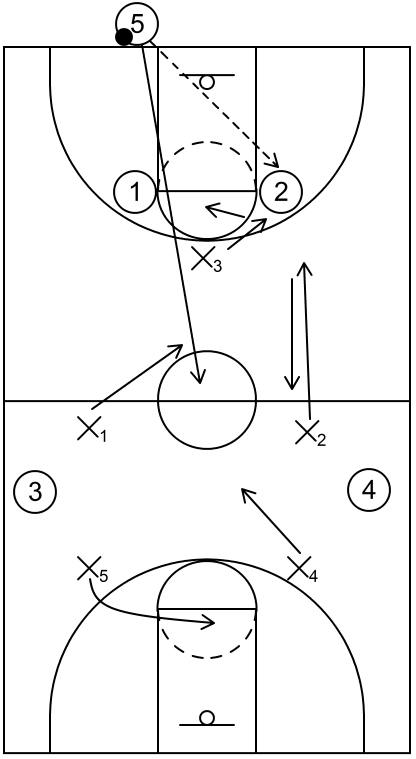
For this particular 1-2-2 press variation, X3 starts at the top while X4 and X5 start near the slot areas above the three-point arc in the frontcourt.
However, X1 and X2 begin near the half court line in the frontcourt as opposed to the backcourt, similar to what was shown in previous examples.
Also, Coach Wright said that the defender at the top can basically be any size as long as that defender is the quickest and/or most athletic defender on the court.
Therefore, for demonstration purposes, it is assumed that X3 is the most athletic defender on the court. In addition to that, the offensive team will implement a 2-1-2 alignment as a strategy for breaking the press.
To initiate the overall action, 2 receives the ball from 5 via the inbound pass at the backcourt baseline and following that, 5 sprints into the middle of the court to complete the 2-1-2 alignment.
From that point, if 2 begins to dribbles the ball, then X3 and X2 have the option to set a trap early or fake a trap.
If X3 and X2 trap early, then X3 would influence 2 towards the nearest sideline while X2 steps into the backcourt to set the trap, similar to previous examples.
However, for this diagram, X3 and X2 decide to fake the trap in the backcourt.
When that occurs, X3 and X2 should attack small with their knees bent using short choppy steps, similar to a defensive closeout, but then retreat big by backpedaling with their back straightened, and hands high above their shoulders.
Coach Wright said that the general notion of the fake trap is to influence the player with possession of the ball (in this case, that would be 2) into thinking that they are being trapped.
Afterwards, if the offensive player picks up the ball so that they can pass it to a teammate, then the defenders that faked the trap (in this case, that would be X3 and X2) should retreat to take away any possible adjacent passing options.
This means that after executing the fake trap, X3 would retreat to stand in the gap between 2 and 1 while X2 retreats to stand in the gap between 2 and 4.
Also, as that occurs, X1 sprints into the backcourt to take away the possible passing option to 5.
Furthermore, X4 steps into the gap between 3 and 4 as if to take away any passes thrown in that direction.
However, this is simply false defensive action that is designed to influence 2 into throwing the ball towards 4.
If that were to happen, then X4 should have enough time to step into that passing lane near 4 and deflect or intercept the ball.
Also, 5 drops back towards the lane slightly below the middle of the free throw line to take away possible passing options over the top of the defense.
From that point, it would be very difficult for the offense to advance the ball down the court, particularly after 2 picks up their dribble.
Part 2
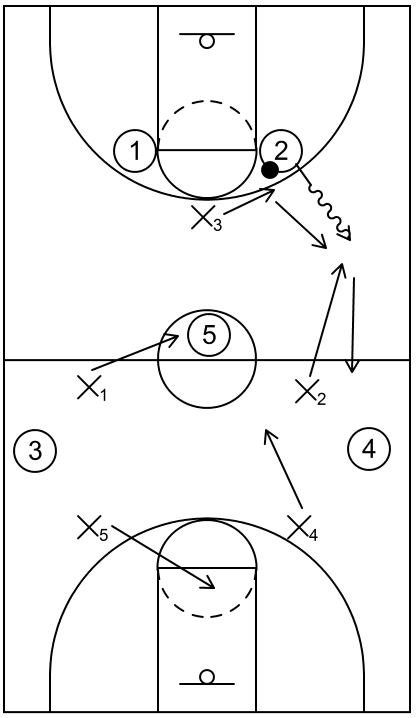
For this part of the example, let’s say that X3 is able to influence dribble action by 2 towards the nearest sideline.
When that happens, X2 could fake a trap with a small attack and big retreat while X1 continues to take away the middle.
Also, X4 stands in the gap between 3 and 4 while X5 drops back towards the lane once again.
Part 3
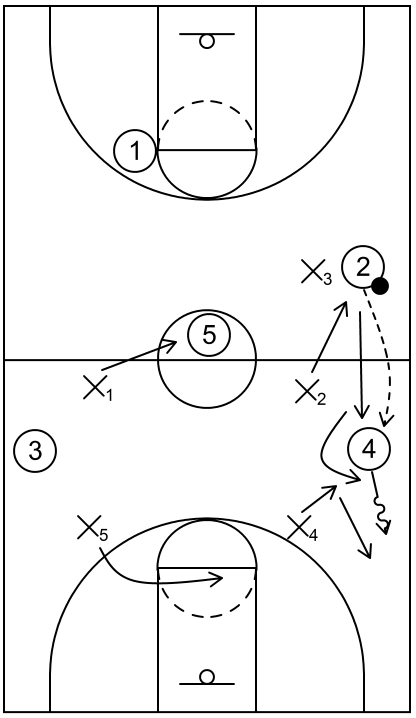
Next, let’s say that 2 continues to dribble down the sideline while X2 continues to fake trap. Afterwards, if 2 is able to throw the ball over the hands of X2 so that 4 could receive it, then this triggers the actual trap.
Essentially, when 4 receives the ball, X4 executes a defensive closeout to contain the ball near the sideline. As that occurs, X2 chases behind to set the trap near the sideline with X4.
Part 4
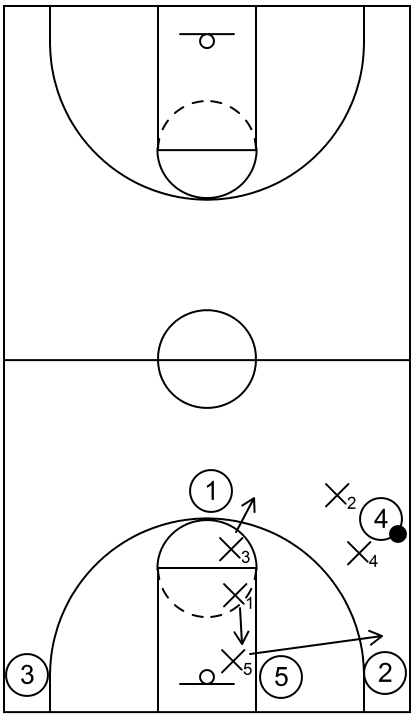
Once X2 and X4 have established a trap near the sideline, all other off-ball defenders sprint into the frontcourt, particularly near the paint, below the level of the ball near the strong side of the court.
After that action occurs, if there is an adjacent offensive player one pass away near the ball, then the lowest defender could sprint out to execute denial defense.
For this case, this means that 5 would sprint out to deny the potential pass towards 2, who is stationed in the corner. Also, at the same time, X1 could fill the area vacated by X5 so that a defender is still available to protect the basket.
Moreover, X3 could also deny the possible pass to 1 at the top or if 3 tries to cut across the lane to receive the ball, then X1 or X3 could deny that as well.
From that point, if 4 throws a skip pass across the court, then all of the defenders could convert, which eventually leads into man to man defense.
Part 5
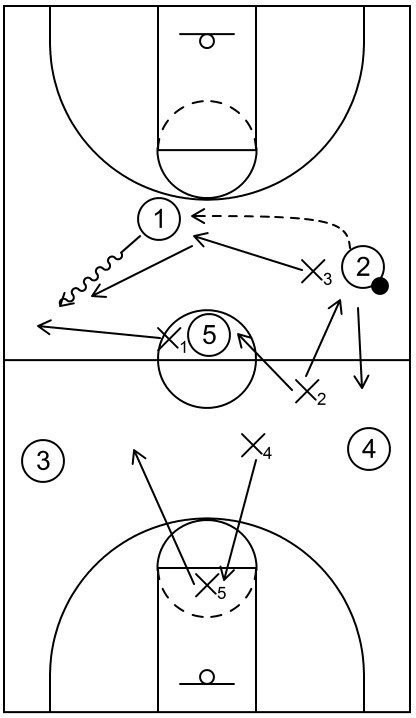
For this part, let’s say that 2 initially dribbles down the sideline while X2 attacks small and retreats big.
However, let’s also say that 2 does not feel comfortable throwing the ball ahead to 4. So instead of doing that, 2 decides to throw a backwards pass to 1. When that occurs, X3 sprints to the ball to influence 1 towards the nearest sideline.
Also, as that happens, X2 sprints toward 5 to take away the middle. Moreover, it should be mentioned that X1 should stay in the middle until X2 gets there because if X1 leaves too early, then 5 could potentially receive the ball from 1 and that would effectively break the press.
Next, if 1 dribbles toward the sideline, then X1 could sprint to set a trap in the backcourt with X3.
Also, as that action happens, X5 could lift up to stand in the gap between 3 and 4 while X4 drops back to fill the area vacated by X5.
From that point, everything else would be similar to the previous diagram that was on the other side of the court.
It should be mentioned, though, that in regard to this secondary trap in the backcourt, Coach Wright said that when playing against the best teams in a league or conference, it is probably better to simply activate conversion as soon as they pass out of the first trap.
Coach said that, in most cases, the best offensive teams know how to pass the ball out of the first trap and quickly move it diagonally ahead into the frontcourt, particularly so that they can take three-point shots before the defense has time to properly react.
What are comparable defensive strategies in relation to the 1-2-2 press defense
The 1-1-2-1 press defense is a full court press that makes use of sideline traps to potentially create turnovers. This particular press utilizes defensive pressure in the backcourt and afterwards, defensive players set the sideline traps in the frontcourt, typically near the half court area.
The 1-1-3 press defense is a full court press that makes use of sideline traps to potentially create turnovers. This particular press starts off very aggressive as the three defenders in the back of the press are pushed up towards the half court line with little to no initial rim protection.
The 1-2-1-1 press defense, also known as the diamond press, is another full court press that utilizes sideline traps to create turnovers. This particular press could be implemented by teams with speed, quickness, and very good conditioning. Also, a difference between this press and the 1-1-2-1 press defense is that the diamond press features sideline traps in the backcourt as opposed to the frontcourt.
The 1-3-1 press defense is a type of basketball defensive strategy that implements traps near the sidelines, which in turn, could limit offensive scoring opportunities. A unique attribute of this press is that it begins with only one defender in the backcourt while the other defenders typically remain in the backcourt.
The 2-2-1 press is another full court press defense that features frontcourt and backcourt sideline traps. This particular press could be good against teams that have average or less than average basketball IQ.
The havoc press is a variation of the 1-2-1-1 press and it was popularized by Coach Shaka Smart, particularly during his time as the head coach of the VCU Rams men’s basketball team.